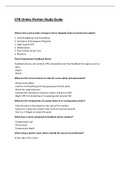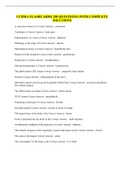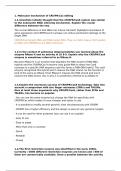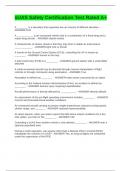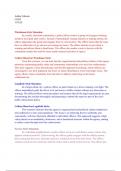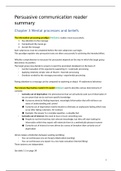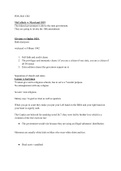Mike Verweij
LECTURES & ARTICLES
2018-2019
,Table of contents
Intensity .................................................................................................................................................. 3
Lecture 1 – intensity & load (1/3) ...................................................................................................... 3
Lecture 2 – intensity & load (2/3) ...................................................................................................... 4
Lecture 3 – intensity & load (3/3) ...................................................................................................... 5
Achten & Jeukendrip - heart rate monitoring: applications and limitations ................................... 8
Borressen & Lambert - the quantification of training load, training response and the effect on
performance. ...................................................................................................................................... 9
Foster et al. - Monitoring training loads: the past, the present and the future ............................ 10
Mujika – Quantification of training and competition loads in endurance sports: methods and
applications ....................................................................................................................................... 10
Lecture 4 – critical power (1/3) ........................................................................................................ 12
Lecture 5 – critical power (2/3) ........................................................................................................ 14
Lecture 6 – critical power (3/3) ........................................................................................................ 15
Morton – the critical power and related whole-body bioenergetic models .................................. 17
Vanhatelo et al. - Application of Critical Power in Sport................................................................. 19
Walsh – Whole body fatigue and critical power ............................................................................. 20
Poole et al. – critical power: an important fatigue threshold in exercise physiology ................... 21
Lecture 7 – Q&A intensity................................................................................................................. 21
Stability ................................................................................................................................................. 22
Lecture 8 – core stability .................................................................................................................. 22
Leetun et al. – core stability measures as risk factors for lower extremity injury in athletes ....... 24
Zazulak et al. - Deficits in Neuromuscular Control of the Trunk Predict Knee Injury Risk ............. 24
Reeves - spine stability: the six blind men and the elephant ......................................................... 25
Lecture 9 – stiffness & damping in biological structures................................................................. 26
Cholewicki et al. – stabilizing function of trunk flexor-extensor muscles around a neutral spine
posture .............................................................................................................................................. 28
Lecture 10 – discussion & application ............................................................................................. 28
Van der Esch - Joint laxity and the relationship between muscle strength and functional ability in
patients with osteoarthritis of the knee. ......................................................................................... 29
Lecture 11 - feedback........................................................................................................................ 30
Reeves - spine stability: the six blind men and the elephant ......................................................... 32
Reeves - spine stability: lessons from balancing a stick .................................................................. 33
Lecture 12 - measurement ............................................................................................................... 33
Hof - control of lateral balance in walking; experimental findings in normal subjects and above-
knee amputees ................................................................................................................................. 36
Granata - fatigue influences the dynamic stability of the torso ..................................................... 36
1
, Lecture 13 – discussion & application .............................................................................................. 37
Lecture 14 – Q&A stability ................................................................................................................ 38
Coordination ......................................................................................................................................... 39
Lecture 15 - information ................................................................................................................... 39
Körding & Wolpert – bayesian decision theory in sensorimotor control ....................................... 41
Michaels & Carello - direct perception ............................................................................................ 41
Lecture 16 – sensorimotor loop ....................................................................................................... 42
Wolpert & Ghahramani – computational principles of movement neuroscience ......................... 45
Lecture 17 – perception-action coupling ......................................................................................... 45
Michaels & Oudejans – the optics and actions of catching fly balls: zeroing out optical
acceleration....................................................................................................................................... 47
Hommel et al. – The theory of event coding (TEC): a framework for perception and action
planning ............................................................................................................................................ 48
Lecture 18 – synergy ......................................................................................................................... 49
Safavynia et al. – muscle synergies: implications for clinical evaluations and rehabilitation of
movement ......................................................................................................................................... 51
Lecture 19 – Q&A coordination ........................................................................................................ 51
2
, Intensity
Lecture 1 – intensity & load (1/3)
Ultimate goals:
Sports: produce a winning performance at the right time and place.
Rehab: to enhance and restore functional ability and quality of life of those with physical impairments
of disabilities
You need to improve → understand the mechanism!
Overload: apply more stress on the body than the athlete is normally got to improve → body will adapt
most of the time; dependent on many factors → FIT triad:
Frequency: how often do the load
Intensity: how high intensity → difficult to monitor.
Time: how long
Side effects → injury etc.
Fine line between optimal load and overtraining → You need a good intensity to improve, but not to
high → looking for the limits.
Tapering
Optimal training → reduce intensity → decrease in performance.
Tapering: reduce training load (number of sessions/ time, but not intensity!)
What is exercise intensity?
Is it really difficult to define intensity. It is a combination of the parameters which are related to the
performance output, energy expenditure and the subjective feeling of the athlete.
- Performance output → really what you do:
• Absolute force/power/velocity → coordinated action (GPS), isolated muscle group.
This does not always reflect intensity → many influencing factors (terrain,
environmental conditions, etc.)
• %MVC, %Pmax → related to the maximal performance of the athletes
• Critical power (Pcrit): highest power output than can be maintained for a very long
time.
- Energy expenditure
• Absolute energy expenditure
• %VO2max, %VO2max or MET
• %HRmax or %HRR (Heart rate reserve) → internal
• Thresholds: anaerobic/lactate/ventilatory → more or less the same
▪ Lactate threshold: exercise intensity at which the body produce more lactate
then it consumes → accumulation of lactate → problem is the acid: pH
decrease, muscles do not function properly anymore.
We know the intensity, how high should it be to improve the aerobic fitness?
50% VO2max/HRR is the minimum, but it is not easy, do we really know?
3

